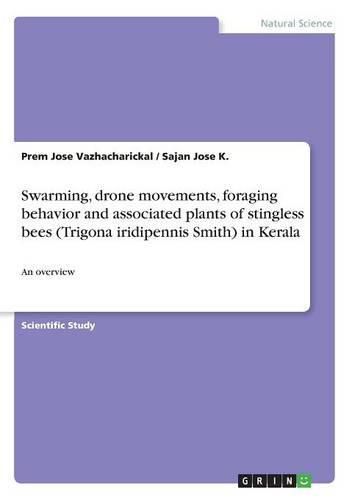Readings Newsletter
Become a Readings Member to make your shopping experience even easier.
Sign in or sign up for free!
You’re not far away from qualifying for FREE standard shipping within Australia
You’ve qualified for FREE standard shipping within Australia
The cart is loading…






Scientific Study from the year 2014 in the subject Biology - Zoology, language: English, abstract: Stingless bees are highly social insects which populated the tropical earth 65 million years ago longer than honey bees. They are limited to tropics and subtropics lacking venom apparatus and cannot sting. Impacts of anthropogenic influences on honey bees were already reported. Based on these back ground, the objectives of this study were to 1) to characterize the swarming and drone movements of Trigona iridipennis Smith in Kerala 2) to identify the foraging behaviour, colour preference and various plants associated with Trigona iridipennis Smith for nest construction as well as dietary sources. Feral as well as hived colonies of stingless bees were located and fixed at different parts of Kerala for observations on their foraging activity. Bee traffic was also measured during various timings across a bright sunny day in November 2013 and between colonies. Bee traffic among Trigona iridipennis Smith varied widely among the selected four colonies during various time intervals. In all the colonies bee traffic starts between 6 to 7 am and end by 7 to 7.10 pm. Bee traffic exhibited two peaks. One during 10 to 10.10 am and the other 2 to 3.10 pm. But in colony 4 the picture is different, where the morning peak was 11 to 11.10 am and the afternoon peak was 3 to 3.10 pm. Trigona iridipennis Smith shows great diversity in plant selection for dietary as well as resin sources. The shift towards ornamental plants for foraging may be an adaptation evolved in response to human modification of the environment. The bees collect resin from a variety of sources for building nest, its maintenance and also for defence. Bee traffic is found to be related to time, season, and strength of the colony. The bees preferred white and yellow coloured flowers than pink and red. The study also highlights the various food sources of Trigona iridipennis Smith in Kerala which can be further expl
$9.00 standard shipping within Australia
FREE standard shipping within Australia for orders over $100.00
Express & International shipping calculated at checkout
Scientific Study from the year 2014 in the subject Biology - Zoology, language: English, abstract: Stingless bees are highly social insects which populated the tropical earth 65 million years ago longer than honey bees. They are limited to tropics and subtropics lacking venom apparatus and cannot sting. Impacts of anthropogenic influences on honey bees were already reported. Based on these back ground, the objectives of this study were to 1) to characterize the swarming and drone movements of Trigona iridipennis Smith in Kerala 2) to identify the foraging behaviour, colour preference and various plants associated with Trigona iridipennis Smith for nest construction as well as dietary sources. Feral as well as hived colonies of stingless bees were located and fixed at different parts of Kerala for observations on their foraging activity. Bee traffic was also measured during various timings across a bright sunny day in November 2013 and between colonies. Bee traffic among Trigona iridipennis Smith varied widely among the selected four colonies during various time intervals. In all the colonies bee traffic starts between 6 to 7 am and end by 7 to 7.10 pm. Bee traffic exhibited two peaks. One during 10 to 10.10 am and the other 2 to 3.10 pm. But in colony 4 the picture is different, where the morning peak was 11 to 11.10 am and the afternoon peak was 3 to 3.10 pm. Trigona iridipennis Smith shows great diversity in plant selection for dietary as well as resin sources. The shift towards ornamental plants for foraging may be an adaptation evolved in response to human modification of the environment. The bees collect resin from a variety of sources for building nest, its maintenance and also for defence. Bee traffic is found to be related to time, season, and strength of the colony. The bees preferred white and yellow coloured flowers than pink and red. The study also highlights the various food sources of Trigona iridipennis Smith in Kerala which can be further expl